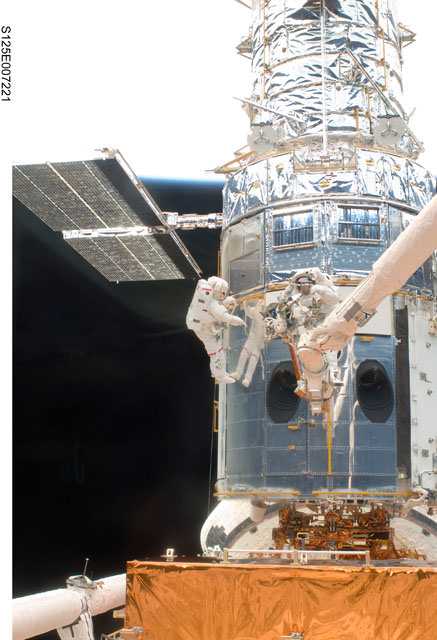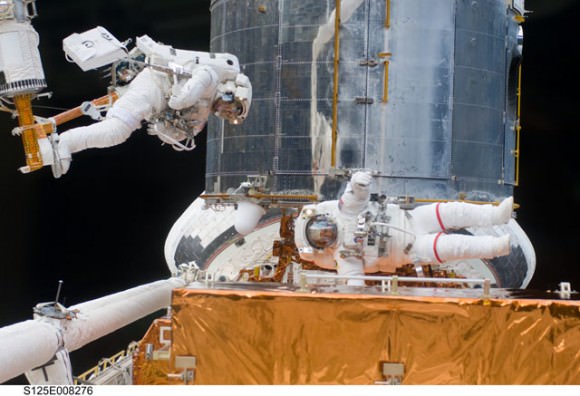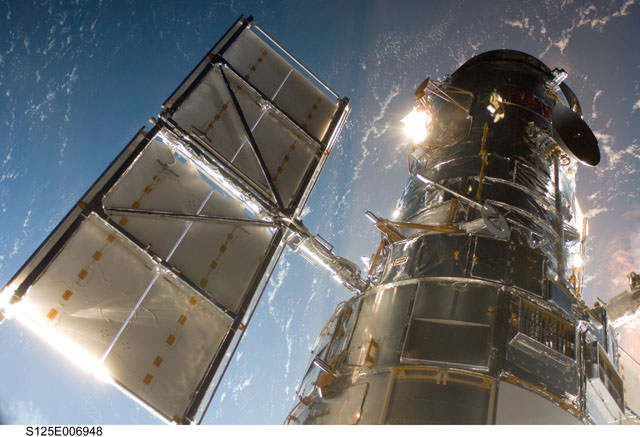[/caption]
The long-awaited Servicing Mission 4 for the Hubble Space Telescope has provided drama, nail-biting excitement, fist-pumping triumphs and ‘what else could go wrong now’ moments. But the best way to to describe the mission is to let the amazing images from the EVAs do the talking. Below are high-resolution images from NASA, highlighting the first three spacewalks.

The mission began with the picture-perfect, no-delay, long-awaited launch on May 11, 2009.
EVA #1

The first spacewalk of the mission, performed by astronauts John Grunsfeld and Drew Feustel lasted a little over 7 1/2 hours. They successfully installed the new Wide Field Camera 3 science instrument and a new Science Instrument Command and Data Handling Unit. Both WFC-3 and the SI C&DH passed their “aliveness” tests, which essentially means the devices powered on correctly. The WFC-3 also passed its functional test, meaning the capabilities of the instrument itself were tested. The SI C&DH unit has also received an initial OK on its functional test, pending final review of data sent down to the ground.

A stubborn bolt threatened to thwart one of the spacewalk’s main goals, replacing the venerable space telescope’s workhorse optical camera with a new and improved instrument. But after a fair amount of old fashioned elbow grease, the WFPC2 was able to be removed.

This close-up of Grunsfeld was taken by Drew Feustel, whose reflection is visible in Grunsfeld’s visor. Feustel is attached to the end of the shuttle Remote Manipulator System, or robotic arm. Grunsfeld was the free-floating astronaut for the EVA.

Here, Feustel, on the end of the shuttle’s robotic arm, carries the piano-sized WFPC3 to its new home inside Hubble.
EVA #2

The second EVA of the mission provided some challenges to astronauts Michael Good and Mike Massimino. However, they achieved all the objectives for this spacewalk, it just took them awhile — 7 hours and 56 minutes. They installed three Rate Sensor Units (RSUs), with a pair of gyros in each, and the first of two new battery module units.

Good and Massimino were not able to get one of the three prime RSUs into its slot but were able to install a spare, giving Hubble the new gyros it needed. The gyros are used to change the orientation of the telescope and keep it fixed on a particular astronomical target during observations.

The spacewalkers also removed one of the original battery modules from Bay 2 of the telescope and replaced it with a new unit. The batteries provide power to the telescope when Hubble passes into Earth’s shadow and its solar arrays are not exposed to the sun. Ground controllers at Goddard’s Space Telescope Operations Control Center confirmed that all six gyroscopes and the new battery passed preliminary tests.
EVA #3

The third EVA of the mission went like clockwork as Grunsfeld and Feustel teamed up again. They removed the Corrective Optics Space Telescope Axial Replacement and installed in its place the new Cosmic Origins Spectrograph. They also completed an unprecedented repair of the Advanced Camera for Surveys replacing an electronic card and installed a new electronics box and cable.

To do the repairs on ACS, Grunsfeld removed 32 screws from an access panel to replace the camera’s four circuit boards and install a new power supply. The two astronauts used specially designed tools to do a job that was never intended to be done on orbit. But they did it, and with efficiency.

Engineers at Goddard have already performed “aliveness” tests on both COS and ACS to verify they have electrical power. However while a functional test of the ACS indicated success in reviving the instrument’s heavily used wide-field channel, officials said early Sunday that it appears the repairs failed to resolve power problem with the camera’s stricken high-resolution channel and it appears “down for the count.”
We’ll keep you posted on any developments with ACS, and provide more high-resolution images from the remainder of the mission soon!
For more images from the mission, or to download higher resolution versions of the pictures here, visit NASA’s Human Spaceflight gallery.


Great work guys!! Seems like we can even built things in orbit after all….Great scope for a lunar mission and further!!
I’m watching the live NASA feed on CNN right now. It’s fascinating to watch!
Whoo Hooo, Looks like they’re so far ahead of the timeline in EVA 5 that all of the protective blanket deployments will proceed, and the FGS ‘liveness’ test just came back great! Definitely NASA has the “Right Stuff’ mojo going!
To whom it may concern:
I speak for one, and for many…
What a waste to let Hubble crash into the ocean, why not send it into deep space on a trajectory similer to that of the Voyager space craft, let the planets slingshot it out of the solar system and beyond ! Turn its camera toward our home planet, to give us a unique view is it travels father away. It would provide us a rare glimpse of our region of the Milky Way.
It`s cost would be minimal, and the data it could send back as it left would be invaluable, to say the least.
Voyager was still sending data to us as it left our Galaxy, why pass up an opportunity like that, and what fitting end that would be for Hubble, who has given us so much !
This note is for the people at NASA and The Hubble Team and all the Agencies/Organizations involved in the Hubble project, think about it before you destroy a craft that changed our view of the Universe…
What would Edwin Hubble want done with the craft that bare`s his name ?
I can think of no better end for our Hubble Telescope. This is a one time chance, a one time opportunity !
In the words of Neil Armstrong; “That’s one small step for a man, one giant leap for mankind.”
The end you propose, for such a Monumental and Nobel Craft, I find Disgusting, And I`m sure the People of the Earth would agree with me.
Have a pole, lets see how the People of the Earth, feel about this, fateless end ! ! !
Yours Truly;
Joseph H. C. Lyrette, a humble Amateur Scientist from Toronto ON. Canada.
[email protected]
To whom it may concern;
I realize that my proposal might seem ludicrous and outrages to some !
But in five years, NASA will be sending a shuttle to give Hubble a booster, which will send it on a course to renter our atmosphere and crash into the ocean.
I propose that we use that booster to send Hubble in the opposite direction on a similar trajectory that we sent the Voyager space craft on.
Turn Hubble`s camera on our own region in space as it leaves, to give us a view none have ever seen before, this I find extremely exciting !
As I mentioned before, Voyager was still sending data back to Earth as it was about to leave our galaxy.
We have an opportunity that would cost no more than the shuttle mission to Hubble to send Hubble to a watery grave in the ocean, which will serve no purpose at all, nothing but the waste of great technology.
It`s already up there, why not use it for further research, and give us a unique view of our place in our galaxy.
Instead of, the end of Hubble this would be a new beginning, at no extra cost to us.
I may be a dreamer, but it was dreams that made early Man go farther and father. And look how far we have come as a species.
I am only one man, so I alone cannot do alot, but with the help of others this dream could be realized.
Hubble has no voice, but if she could speak what do you think she would want, to die or travel on forever.
@Tabuism: It seems like a great, romantic idea! However, I don’t think there’s any way to give the HST enough delta-V to escape the Earth-Moon system, let alone the solar system …
@Tabuism, Nereid: You only need to slow a satellite by a few hundred miles an hour in order to get it to re-enter the atmosphere. But going from orbital to escape velocity requires a speed increase of around 7,000 mph. So you’d need a much more powerful booster to do the latter.
Too, even if you could get Hubble to start heading out of the solar system, it’s powered by its solar panels, which will cease to be useful probably around the orbit of Mars. And this is ignoring all the systems that are going to be failing by the time they give up on HST.
So, it’s a lovely idea, but not at all practical, I’m afraid.
I have been following a lot of this mission on NASA TV. I will never be able to travel in space, but I feel a part of this with bit of this that I watch.
I, too, wish they would not opt to de-orbit the Hubble after its mission is over. I had often thought that it might be able to be nudged enough to allow it instead to drift out in a much higher orbit, maybe past GEO or eventually into one of the Earth-Moon Lagrange points, to serve as a museum piece, a testament to the achievements of our time.
Even as I write this, Hubble is now almost 500 meters from Atlantis, well on its way to resume making cutting-edge astronomical discoveries well into the next decade. Godspeed and congatulations to the mission astronauts and all of the support team down here on on Earth for making SM4 such a resounding success. See you home in a few days 🙂